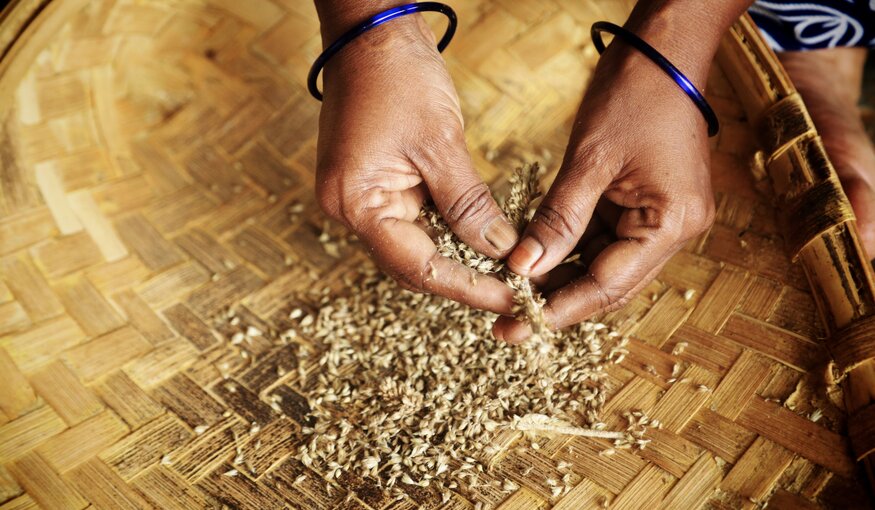Chapatis of Pearl Millet for a Changing Climate

Pearl millet in Hyderabad, India at the International Crops Research Institute for the Semi-Arid Tropics (ICRISAT). (Photo: Shawn Landersz/Crop Trust)
24 July 2023
The people of rural India love their bajra chapatis. These flatbreads made of pearl millet flour are a highly nutritious staple in the diet of millions of Indians. And farmers love pearl millet because it will grow where other crops just don’t have a chance.
But climate change is throwing all kinds of challenges at this cereal crop, which has been grown in Africa as well as the Indian subcontinent since prehistoric times. Today, heatwaves, drought and newly emerging diseases are all contributing to lower yields.
However, a team of scientists from the International Crops Research Institute for the Semi-Arid Tropics (ICRISAT) have made significant progress in developing pearl millet (Pennisetum glaucum) varieties which not only tolerate high temperatures and drier conditions but also resist the devastating fungal disease, blast.
The ICRISAT scientists and their partners worked on a so-called pre-breeding project to identify and transfer beneficial genes from pearl millet’s wild relatives to cultivated varieties. Ultimately, the scientists hope that farmers will be able to grow one of the world’s most important cereals in marginal environments despite a changing climate.
A Smart Food for Millions
“More than 90 million people in about 30 countries depend on pearl millet for food and income,” said Shivali Sharma, formerly the Pre-breeding Theme Leader at ICRISAT and now a consultant with the Crop Trust. Pearl millet, the sixth most important cereal crop globally, is grown in the arid and semi-arid tropical and subtropical regions of Asia, Africa and Latin America. It is a dependable source of energy, but also meets other dietary needs too, especially micronutrients.
Pearl millet is mainly grown in harsh environments with marginal soils and in areas with low rainfall where other major cereal crops fail to grow. The crop can tolerate temperatures of up to 42°C, whereas other cereals, like maize (40°C) and rice (32°C) and wheat (30°C), just can’t handle the heat. But climate change means farmers need crops that are tolerant of even longer and hotter heatwaves and even less rainfall, not to mention new diseases.
Stagnating Yields
The changing climate is reducing yields of pearl millet in African countries and in India. Breeders have been tasked with developing new varieties that can adapt to these changes.
The genetic diversity in domesticated pearl millet is limited, so breeders look to closely related species in the wild for their raw materials. Some of these distant cousins may have developed the characteristics which breeders need.
Shivali and the team at ICRISAT had a considerable amount of diversity to choose from. ICRISAT’s genebank holds nearly 24,000 seed samples of pearl millet, including 794 samples of wild relatives. The challenge was to find which of those samples hold the traits the breeders are searching for.
Crop Wild Relatives Help Build Tolerance to Heat
“Crop wild relatives are an excellent reservoir of valuable genes for resistance to the stresses caused by climate change,” Shivali said. “For example, the wild cousin of domesticated pearl millet, called subspecies violaceum, grows in the very hot and dry conditions of the Sahel region of Africa. We hope to be able to exploit this adaptation and introduce the relevant genes into domesticated pearl millet.
“We evaluated for heat tolerance four pre-breeding populations derived from wild Pennisetum violaceum and cultivated pearl millet in different locations in western and northern India where the air temperature is more than 42°C at the time of flowering and much higher during heatwaves. These populations were also evaluated for terminal drought tolerance in northern India.”
Shivali and her colleagues measure tolerance to heat by determining how many seeds form in the cluster of flowers at the top of the plant (known as “seed set”). “We set a benchmark at 70% seed set at 42°C as this is what the best commercial hybrids achieve. We were able to identify more than 40 pre-breeding lines across three trial sites that could equal or better this benchmark.”
Blast: A Newly Emerging Pearl Millet Disease
The wild relatives also helped in the search for blast resistance. Blast, which is caused by the fungus Magnaporthe grisea, has emerged as a serious disease of pearl millet in India and Africa in the past decade. For example, in East Africa losses exceeding 80% have been reported in bad years. Commercial hybrids do not have resistance to this emerging disease.
Breeders from national agricultural research systems and seed companies have been quite vocal in their desire to see more blast resistance. “After consulting with scientists in both the public and private sectors, we identified blast as the number one research priority,” said Rajan Sharma, a plant pathologist at ICRISAT.
The ICRISAT team discovered that some populations of Pennisetum violaceum found in Chad and Niger had resistance to blast and also has some good agronomic characteristics. They crossed them with the domesticated pearl millet and developed four pre-breeding populations for further screening for blast as well as evaluation for flowering-stage heat tolerance and terminal drought tolerance.
Diseases like blast can be caused by different forms of the same species of fungus, called pathotypes. “We looked for lines that have resistance to multiple pathotypes,” Rajan said. “We found some which have resistance to five pathotypes of blast, including a highly virulent one known as Pg 138.”
Bridge to Breeders
“This means that we now have ample genetic material to introduce into programs so breeders can develop varieties that outperform the currently used cultivars, not only for heat tolerance but also for other agronomic traits,” Shivali said. “It’s a triple win!”
The screening success in the various locations throughout India is music to the ears of pearl millet breeders. “We are eager to start using this material in our breeding programs,” said S.K. Gupta, pearl millet breeder at ICRISAT. “The sooner we can use these lines in our breeding programs, the sooner it will lead to improved varieties for farmers.”
Working with Partners
This work was part of the global Crop Wild Relatives Project, funded by the Government of Norway and managed by the Crop Trust. As the leader of this pre-breeding component of the project, ICRISAT has forged strong partnerships with both private-sector companies and public-sector research organizations. The private partners–Pioneer Hi-Bred, Bayer BioScience, Metahelix Life Sciences–and a public-sector partner, the Chaudhary Charan Singh Haryana Agricultural University, have joined forces to evaluate the pre-breeding material in various locations throughout India.
“The involvement of partners from private industry make this pre-breeding project unique,” said Shivali. “Pioneer, Bayer and Metahelix have major shares in the pearl millet hybrid market, so we wanted to get them all involved in the project and get their feedback. They have already helped us identify promising lines based on their past experience meeting the needs of farmers and consumers.”
It’s a two-way street, as the partners have reaped a number of benefits as well. “We evaluated the products from this project for heat tolerance in North Gujarat,” said A.K. Jayalekha, formerly the lead pearl millet breeder at Bayer BioScience. “Bayer already have a very good heat tolerant hybrid, 9444, which is selling in the market, but the company is always looking to improve yield. Previously the company wasn’t using crop wild relatives in its breeding program, but from what we have seen so far, I expect that this project will provide ample material the company can use.”
A Bit of the Wild in Those Chapatis
The ICRISAT team is continuing to work with these partners in the private sector. “The Crop Wild Relatives Project is delighted with the success that Shivali and her team had,” says Benjamin Kilian, a scientist with the Crop Trust who coordinated the Crop Wild Relatives Project.
By introducing a bit of the wild into our domesticated pearl millet, Shivali and her team are helping to ensure bajra chapatis will always be on the table.
This pre-breeding project was part of the Crop Wild Relatives Project, ”Adapting Agriculture to Climate Change: Collecting, Protecting and Preparing Crop Wild Relatives,” funded by the Norwegian Government, and coordinated by the Crop Trust with the Millennium Seed Bank, Kew. This project concluded in 2021.
All material collected under the Crop Wild Relatives Project is shared under the terms of the Standard Material Transfer Agreement within the framework of the multilateral system of the International Treaty for Plant Genetic Resources for Food and Agriculture.
Categories: Pearl Millet, Climate Change, Food Security

